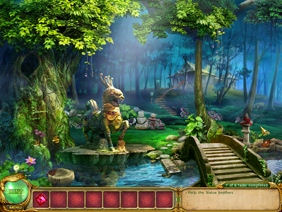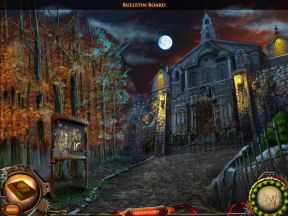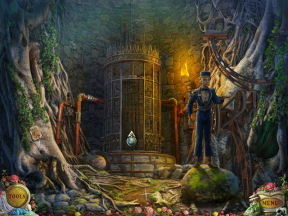Hidden Objects: The
Stories They Could Tell -- Quests
By Becky Waxman
This is the
second in a series of editorials about storytelling in Interactive Hidden
Object Games (IHOGs). In a
previous editorial I discussed character-driven IHOGs, which
tend to be linear, with well defined characters, twisty plots, and
challenges that often spring from the protagonist's talents or abilities.
The games I am about to
describe are quite different from character-driven games and have a
greater sense of freedom. The personality of the protagonist is not as
developed as in character-driven games, and the plot is usually less
complex. The game environments are much larger and encourage nonlinear
exploration -- allowing the gamer to choose what to examine first and (to
some extent) the order in which to take on challenges. (This may involve
significant back-and-forthing through the gameworld.)
The gamer slips into the
protagonist's role, not by solving puzzles related to the protagonist's
character or occupation, but by being caught up in the urgency of a quest.
Most of the puzzles spring from the forbidding, often fantastical
environments that the hero sets out to explore, understand, or conquer.
Some examples: the hero might be challenged to rescue people, restore
natural environments, repair mechanisms, explore under water, enable
portals to alternate realities, travel in time, bypass guards or security
systems, and use magical or chemical concoctions.
The Hero Quest
The hero quest or hero's
journey is a common narrative theme in books, films, and games, sending
the protagonist to an unfamiliar, foreign place or to a familiar place
that has been radically transformed by time or disaster. In order to "find
himself," the hero must first lose himself and then struggle to discover a
way back. The quest is a test of character; courage and self-sacrifice are
common themes. The quest can also be a journey into hidden or unpleasant
truths, where knowledge acquired or actions taken are essential for
setting things right upon the hero's return. The stakes are always high,
with the fate of a family, a village or even a civilization resting on the
hero's shoulders.
Non-player characters (NPCs)
encountered on quests may be victims or allies of the villain or even
heroes who have previously failed the quest. The NPCs sometimes have
knowledge that the hero needs, or they guard artifacts and ancient/sacred
places. Often they are not fully developed as characters, but are there as
gatekeepers or task-givers.
The villain in IHOG hero
quests usually doesn't get a lot of screen time. He may be a shadowy
character with one particular ambition -- eternal youth, absolute power,
or revenge. His influence is felt in the environment or through the
actions of other characters. The hero must learn enough about the villain
to locate and/or identify him and then (since a handy policeman is never
around to make an arrest) figure out how to defeat him. Sometimes the
environment itself becomes a "villain" in the form of storms or natural
disasters.
Below are six examples of
IHOGs with a hero quest (or heroine quest, since many of the protagonists
are female). These could be broadly classified as games with fantasy,
historical fantasy, disaster, science fiction, and horror themes. I've
also included a game that would probably best be described as a dark fairy
tale.
*Note:
I'm aware that many gamers partner with their young
children to play IHOGs. I've put an asterisk in front of each game that is
more appropriate for teens and up, rather than young children. There were
two close calls. Shaolin Mystery: Tale of the
Jade Dragon Staff
is
appropriate for children until the end of the story, when there's one
brief but indelibly violent image. Time Dreamer has a couple of
vulgarities in it, but otherwise is appropriate for children, except that
the atmosphere is dark and the plot moves between different time periods,
so that a child might have trouble following it.
A Gypsy's Tale: The Tower of Secrets


Set in a fantasy world not unlike that of
the King's Quest games, A Gypsy's Tale contains the most
nonlinear story of all the games discussed here. You assume the role of
Reylin, a wandering gypsy hired to break the curse on a tower. You learn
that there's more to breaking curses than originally envisioned and that
much goes on beneath the surface.
The graphics are painterly and nostalgic.
The atmosphere is quaint, with forest scenes and dwellings that would
accommodate a hobbit, should one drop by. The environments are meant to
charm and entice; until the game's end they are lovely and welcoming,
though evil's influence is also apparent.
The game starts out slowly, but picks up
as you begin to meet the characters, including a gnome, a water horse and
a real estate agent (the interactions are brief and the characters are not
voiced).
The Hidden Object (HO) challenges include
finding items in various categories and searching for items or parts of
items shown as images surrounding a wheel. In the latter instance, once
found, the items automatically combine to form the finished object.
Puzzles include inventory challenges, pattern puzzles, and creating
potions and other concoctions.
Many tasks involve solving something
that's gone wrong in the environment -- bringing a garden back to life,
fixing a fountain, making it rain, healing a deer. You'll nearly always be
doing several tasks at once. You can wander through the gameworld, but
there's also a map with hotlinks. This nonlinearity works with the story,
partly because the map makes it easy to visit every location to see if
anything has changed or if the characters have something new to say. (One
downside to the game's nonlinearity is the role of invisible triggers; if
you miss a trigger you might have to resort to the hint system in order to
progress.) The game toys with your expectations as to how a story in a
fantasy world ought to unfold, and it provides a satisfying ending.
*Shaolin Mystery: Tale of the Jade Dragon
Staff


This is a journey through ancient China
and through fantasy environments that house fragments of the fabled jade
dragon staff. Our heroine -- a young woman named Yu -- watches as a
childhood friend, Zihao, is arrested by the Imperial guards. She manages
to talk to him in prison, and he reveals that he is the true emperor,
trying to escape his power-usurping uncle. Zihao's execution looms unless
Yu can reassemble the fabled jade dragon staff, which will allow Zihao to
take his rightful place on the throne.
Yu is loyal, resourceful and determined,
though not much else of her personality is revealed. The villain is a
distant figure -- his rule is characterized by encounters with the
oppressed city dwellers, rebels, and prison guards. The story unfolds in
chapters, with cut scenes showing still images, and with a narration
voiced by the heroine between chapters (character dialogs aren't voiced).
By game's end, Yu has witnessed strange and wonderful sights in the realms
of myth, and is beginning to understand the depth of magic and myth.
The graphics appear hand drawn and include
city locations as well as magical environments with monumental structures,
spectacular flora and odd fauna. Varied animations add a sense of ambient
movement. The locations -- especially later in the game -- evoke a sense
of mystery and awe; they are meant to fascinate and intimidate. Each
location has creatures to converse with, though dialogs are so brief that
character interaction is overwhelmed by the mystery and color of the
landscapes.
Puzzles include inventory challenges,
pattern analysis, assembly challenges and mini-games with Asian themes.
You will be manipulating the environment -- replacing missing crystals,
adjusting weights, snaring insects, awakening dormant spirits. Each
location has HO "find" lists with unusual objects to admire. Each location
also contains images arranged in a circle that depict items that must be
found. The image wheel challenges seemed to fit the environments and the
story better than the "find" lists. A diary, or some way to provide a bit
of background information about the fantastical places Yu explores, would
have satisfied this gamer's desire to know even more.
*Nightmare on the Pacific (Premier
Edition)



The good ship "Neptune" has wandered into
the path of a hurricane, and during a brief lull, rescue helicopters
attempt to evacuate everyone on board. One passenger, Sarah Brooks,
chooses to remain on the sinking ship because she knows that her children
and husband are trapped somewhere below. Can she find them and get them
out before the ship goes under?
This game uses a current day setting and
naturalistic graphics, but the normally safe environment of a cruise ship
has become a horrifying mockery of itself, as the ship founders, breaks in
half, and part of it turns upside-down. You are dealing with rising water,
failing electrical systems, locked doors, massive chunks of debris, and
even an opportunistic shark.
I didn't expect the drama of a disaster
story to work well with HO "find" lists, but Nightmare on the Pacific
combines the two surprisingly well. It makes sense, under the
circumstances, that items have fallen, skidded across the deck, and ended
up in a heap. It's fascinating to see what has happened to the inside of
the ship as the storm slowly rips it apart. In the pub area, for instance,
you could have a drink at the underside of the bar, should you choose.
(Bottom's up!) The groaning of the ship's timbers and various watery
noises are accompanied by ominous music that merges with the sound layer.
The main character's voiceovers are believable and add to the atmosphere
of urgency and strain.
In addition to the "find" lists, the game
contains inventory puzzles, and challenges in which you unlock or force
doors to open, restore valves, put out a fire and remove a chandelier. The
Premiere Edition includes a prequel which adds a brief backstory and lets
you see a small portion of the ship before the storm strikes.
Time Dreamer


This game has a creepy atmosphere and a
surprisingly sophisticated story, especially for a game that otherwise
fits the definition of a hero quest. You awaken from a coma to discover
that your father (a research scientist) is now dead and your hometown is
being taken over by your father's employer -- a corporation called INFAM
(it isn't clear at first if this is supposed to have the sense of "in the
family" or "infamous").
You are visited by a friend of your
father's named Giovanni, who has steely eyes and an odd little moustache.
Giovanni explains that you have an unusual talent -- you can travel
through time while you sleep, theoretically granting you the chance to
change reality. Giovanni wants to help you mold the environments in the
past so that your father will still be alive in the present.
In Time Dreamer, you not only
travel into the past, but also into the future. Graphics in the game are
sometimes naturalistic, and at other times surreal, and the locations are
more restrictive than in the other hero quest games I've described. You
visit your home at various stages in time, plus the INFAM offices -- going
from the corporation's modest beginnings to its futuristic culmination.
Quirky music adds greatly to the atmosphere.
During your travels, you will interact
briefly with other characters; dialogs are unvoiced. You will uncover
family secrets and evidence of dirty dealing. As your understanding
increases (despite slip-ups), you begin to make better time-related
decisions.
The game features inventory puzzles,
sabotage challenges and HO "find" lists, some with a wacky sense of humor.
Certain items foreshadow events in the game and perhaps give an alternate
explanation for what's going on. On the "casual" setting, you can choose
to see items in silhouette in addition to the word descriptions.
The plot in Time Dreamer advances
in nonlinear chunks; at points I felt as though I was hanging onto the
correct sequence of events by mere fingertips. Reading the diary helps
greatly to keep track of time periods, what's going on in each, and the
results of the changes made in time.
*Nightfall Mysteries: Asylum Conspiracy


Strong-willed, and well-intentioned,
Christine has left her home and travelled to an isolated island after
receiving a letter from her grandfather. Cut off from civilization, she
finds an (almost) abandoned asylum.
Christine's task is to find out what has
happened in the past at this ominous place, and, with the help of others,
decide what to do about it. The game gradually gives up its secrets as
Christine puzzles her way through the asylum and deep into the island.
Cassette tapes left by previous inhabitants give a patchwork auditory
record of events, and tease as much as they explain.
Challenges include inventory puzzles,
placing items in the correct order, and solving complicated locks. The
asylum is built to impede anyone attempting access -- many of the tasks
involve bypassing the security measures. Much of the place is tumbling
down, so that fixing machinery to gain access is also important, as is
creative use of certain medical equipment. The game contains traditional,
close-up "find" lists. Sometimes the HO screens are eerily beautiful.
Other times they are distinctly unsettling -- especially the ones with a
bizarre sense of humor.
Asylum Conspiracy
has an antique, hand painted look, sometimes glowing with iridescent
light. Odd angles throw the viewer off guard. The various locations speak
of terror, pain, luxury and cruelty. (The notebook contains a map, but it
is not hot linked.) You wouldn't expect an asylum to draw the you in, but
somehow this one does.
Dialogs with a handful of characters are
brief. Voiceovers are excellent. You learn snippets of the characters'
histories -- enough to make them sympathetic, though not enough to feel
deeply involved. They seem alarmingly willing to let Christine continue on
alone to confront an ultimate evil. By the end of the game, you have an
inkling as to what is behind the horror, and will probably be wildly
curious as to how the villain has managed to propagate this scheme for so
long.
*PuppetShow: Souls of the Innocent


Children in a European village have fallen
asleep and can't wake up. You assume the role of an investigator trying to
figure out the cause and provide a cure. Clues in the village lead to an
abandoned castle in a barren valley, occupied by hundreds of animatronic
"puppets." These puppets are similar to the automatons in Syberia,
though definitely creepier. They are the chief characters you meet. (The
game is not voiced.)
Souls of the Innocent
is an odd combination -- a game with dark, sinister themes, yet bright,
hand drawn graphics. The castle is equipped with bizarre contraptions,
many different types of locks and keys, and signs of genius devolving into
madness. An ancient evil, long dormant, has been awaiting the right
catalyst in order to be revived.
As the quest progresses, you encounter
different variations of the human form -- the puppets, dolls, figures in
paintings, skeletons -- most in a stage of disassembly, decay, or
entrapment. Animations in the game are varied and add considerably to the
queasiness of the atmosphere, as does the unusual background music with
punctuated vocals. Despite the delicate use of color, the environments are
meant to disturb and frighten. The whole effect is wrenching enough that
at one point I abandoned the game and then returned because I had to know
how it was all going to turn out.
Puzzles test your abilities at pattern
analysis, inventory application, and (occasionally) your willingness to
experiment. Repairing, using, or stopping the puppets is part of the
challenge, as is fixing machinery and getting past unusual locks and other
types of barriers. Traditional "find" lists make up the HO challenges.
The castle you are exploring contains
three towers, each harder to reach than the last -- and by the time you
finally mount the steps into the third tower, you are wildly curious as to
what is finally going to be revealed.
Conclusion
To recap: in hero quest Interactive Hidden
Object Games, you are interacting with challenging, expansive, strange and
exotic environments -- much more than with other characters. You have some
degree of control over where you go and the order in which you accomplish
some of the tasks. Nonlinearity often means that the story is fairly
simple and the pace may be uneven. If the story is complex, nonlinearity
means that keeping track of events can be a challenge in itself.
Random Thoughts
Some thoughts after playing the hero quest
IHOGS described above.
Backstory
A few of these games would have been more
satisfying if they had provided more backstory. I personally enjoy
learning more about the gameworld in diaries and journals -- but I know
that extensive text passages aren't necessarily every casual gamer's
favorite thing. Two of the games provide backstory in different,
intriguing ways. Nightfall Mysteries: Asylum Conspiracy contains
cassette tapes scattered throughout the locations that can be played to
give a sense of how the Asylum employees were faring before Christine
arrived. Nightmare on the Pacific (Premiere Edition) provides a
playable prequel level after the main game is complete.
Going at Your Own Pace
Hero quest games can be full
of dramatic tension (Nightmare on the Pacific) or they can be more
contemplative (Shaolin Mystery: Tale of the Jade Dragon Staff). The
nonlinear exploration in these games lets the gamer examine everything
much more closely than she could if this same story was being told in (for
instance) the form of a film. Taking your time and drinking it all in does
tend to reduce dramatic tension -- since the gamer controls the pace, the
pace can become quite slow. As a slow gamer myself, I just want to confirm
that games that give the option to take things slowly are just as
enjoyable (in fact, more so) than games that speed things up by using
timed challenges. Slow gamers appreciate having a "relaxed" vs. "timed"
option, and, as a result, probably come through the experience with an
increased appreciation for all the details in the gameworld.
Heroines and the Men they
Leave Behind
An intriguing aspect of IHOG
hero quests is the issue of the protagonist's gender. Most IHOGs have
female protagonists (this is common in casual games, since the majority of
casual gamers are female). Two of the games noted above involve storylines
in which an able bodied male character with knowledge of the environment
chooses to stay behind while the female protagonist goes on to (what is
for her) an unfamiliar place filled with evils and/or physical dangers.
For the heroine to take on dangers that no one else can face suits the
theme of a hero quest, but this sometimes involves downright odd decisions
on the part of male NPCs. If capable, strong men choose to stay behind,
they need a good reason. Taking care of a child -- the excuse in the games
I've played -- isn't a sufficient reason.
First, Admire Fantastical
Environments -- Second, Look for a Pestle, a Pear and a Peanut
Finally, the issue of "find"
lists. In games like hero quests that are focused on environment-based
challenges, close-up "find" lists -- especially those with items that have
nothing to do with the story or the environment -- tend to disrupt this
gamer's sense of immersion. Partly it's because I have to suddenly start
thinking verbally (keeping random words in memory, most of which have
nothing to do with the quest). Partly it's because the close-up areas are
often different in appearance (and sometimes different in theme) than the
rest of the gameworld. In my experience with hero quest games, HO
challenges that use image wheels or fragments of objects are better at
retaining that sense of immersion in the environments, unless great care
is taken to make the "find" lists suit the environment and overall theme.
Coming Up Next
Look to this space to see more discussion
of stories in casual games. But first, a slight detour into a different
theme, the next installment in this series: "Casual Adventures -- Testing
the Atmosphere."
**Hero quests in IHOGs bear
some resemblance to Joseph Campbell's conception of the monomyth. You can
read more about it at Wikipedia.
copyright © 2011
GameBoomers